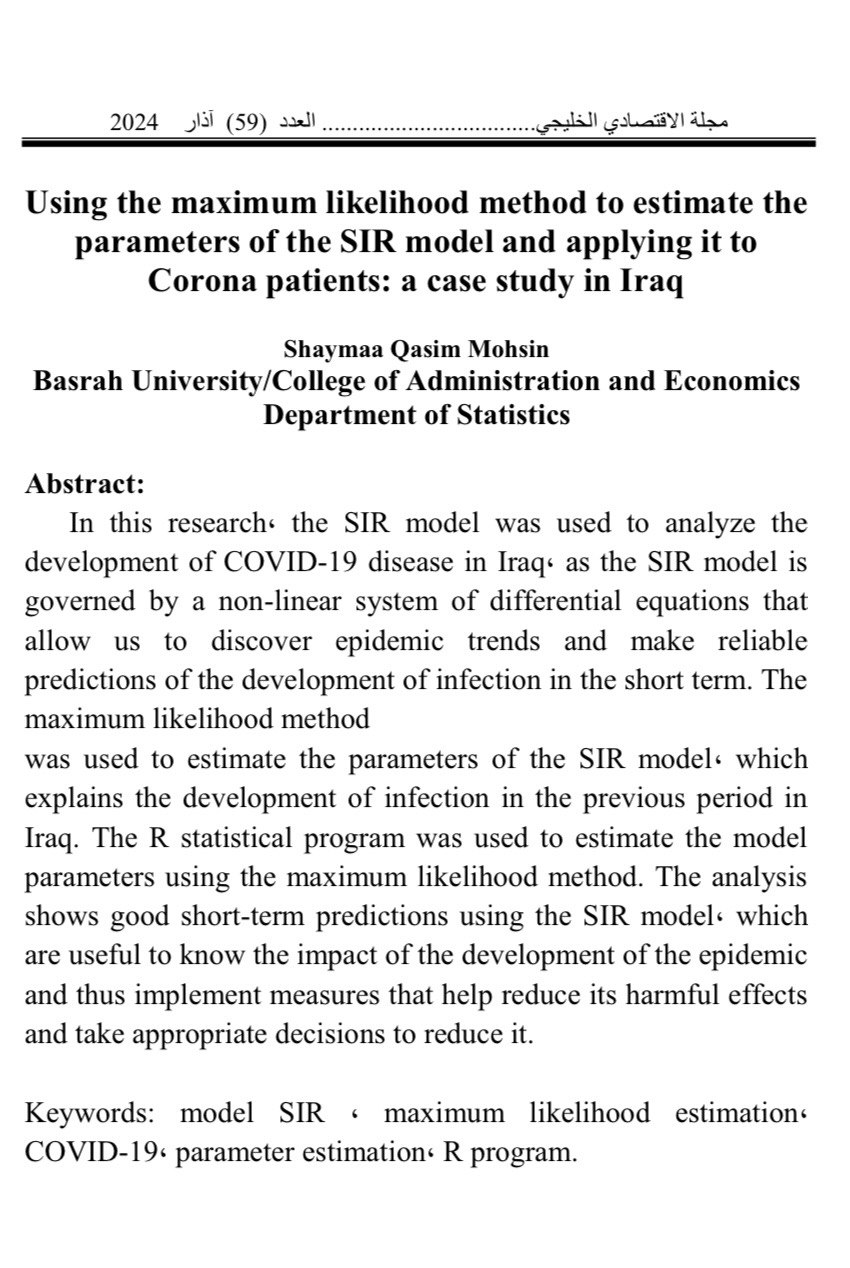Using the maximum likelihood method to estimate the parameters of the SIR model and applying it to Corona patients: a case study in Iraq
Main Article Content
Abstract
In this research، the SIR model was used to analyze the development of COVID-19 disease in Iraq، as the SIR model is governed by a non-linear system of differential equations that allow us to discover epidemic trends and make reliable predictions of the development of infection in the short term. The maximum likelihood method
was used to estimate the parameters of the SIR model، which explains the development of infection in the previous period in Iraq. The R statistical program was used to estimate the model parameters using the maximum likelihood method. The analysis shows good short-term predictions using the SIR model، which are useful to know the impact of the development of the epidemic and thus implement measures that help reduce its harmful effects and take appropriate decisions to reduce it.
Article Details

This work is licensed under a Creative Commons Attribution-ShareAlike 4.0 International License.
References
Anderson، Roy M.، May.Robert M. ، and B. Anderson.(1992) Infectious Diseases of Humans Dynamics and Control (Oxford Science Publications). New York: Oxford UP، USA،.
Araujo، and Naimi.(2020) Spread of SARS-CoV-2 Coronavirus likely to be constrained by climate. MedRxiv.
Brauer .fred، Chávez، Carlos Castillo(2001)، Mathematical Models in Population Biology and Epidemiology، New York Springer.
Getz، Wayne M.، and Smith. Jamese Lloyd(2005) "Basic Methods for Modeling the Invasion and Spread of Contagious Diseases ". DIMACS Series in Discrete Mathematics and Theoretical Computer Science: 1-23.
Hackborn،Bill.،(2008) "Susceptible، Infected، Recovered: the SIR model of an Epidemic." University of Alberta: Augustana. Fall.
Hadeler.K.P،(2011) “Parameter estimation in epidemic models: simplified formulas،” Canadian Applied Mathematics Quarterly، vol. 19، no. 4،.
Hethcote.W.H ، (2000)The Mathematics of Infectious Diseases، SIAM Rev. 42.
Iannelli، M.(2005) "The Mathematical Modeling of Epidemics ". Mathematical Models in Life Science: Theory and Simulation. 1 July. Florida Gulf Coast University.
J. Cui، Y. Sun، and H. Zhu(2008)، “The impact of media on the control of infectious diseases،” Journal of Dynamics and Differential Equations، vol. 20، no. 1، .
Katriel.G، “Stochastic discrete-time age-of-infection epidemic models،” (2013)International Journal of Biomathematics، vol. 6، Article ID 1250066، 20 pages،.27
Keeling M.J .، (2001)"The mathematics of diseases." Plus Magaazine : Living Mathematics. Mar. Fall 2008
Ma.J، Dushoff.J، Bolker، Earn.(2014) Estimating initial epidemic growth rates. Bulletin of mathematical biology، 76(1):
Murray J.D، Mathematical Biology، Springer-Verlag (1993)
O.Diekmann،and،J.A.P.Heesterbeek،(2000)MathematicalEpidemiology of Infectious Diseases:Model Building، Analysis and Interpretation. New York: John Wiley & Sons، Incorporated،.
R. Fierro، V. Leiva، and N. Balakrishnan، “Statistical inference on a stochastic epidemic model(2015)،” Communications in Statistics—Simulation and Computation، vol. 44، no. 9
Rhodes، John A.، and .Allman.S. Elizabeth(2003) ، Mathematical Models in Biology : An Introduction. New York: Cambridge UP، .
SmithRoland David ، and Lang Moore. L.C ، (2001)"The SIR Model for Spread of Disease." MathDL. Dec. 2001. MMA. Fall 2008.
، JM ،and Characteristics of and، McGoogan ،18. Wu.z . (2020)important lessons from the coronavirus disease 2019 (COVID-19) outbreak in Ch ina: summary of a report of 72 314 cases from the Chinese center for disease control and prevention. Jama
